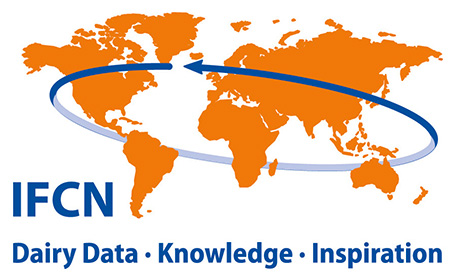
1. Macro-economic developments are pressuring dairy industry
Long-lasting slowdown in global economy is foreseen by World Bank at the start of 2023, affecting all global regions. Income levels are reduced by inflation and currency devaluation. Many countries are experiencing double-digit inflation for several months, which increases living costs and limits purchasing power. The main impact has been on food and energy costs. High energy prices as a result of the current energy crisis affecting both end-consumers and industry, which is further limiting economic activity. Medium- and low-income countries are particularly affected, where the economic slowdown is increasing poverty and food security. Countries which rely on imports, especially for basic commodities, face currency devaluation and a strong USD, thereby making imports even more expensive.
2. Milk price volatility intensifies with the upswing of inflation
World milk price increased by +18% in 2022 to a record high level of an average annual price of 53.3 USD / 100kg of milk. Reaching its peak in April at 63 USD. This increase comes from an imbalance in supply and demand, especially in the beginning of the year. Milk supply was insufficient in many countries due to various reasons: weather constrains, high farm input costs, uncertainties about legislation, etc. This shrinking raw milk pool was especially notable in major milk producing and exporting countries, such as the EU, NZ or Brazil. Conversely, demand was still strong in the beginning of the year, supported by purchasing from China. However, with the impending recession, inflation upswing, and record high prices demand did decline, overcoming the supply disbalance in the second half of the year.
IFCN upcoming events
LIVE EVENT: IFCN DAIRY FORUM 2023
3. High farm input costs affect farmers’ mood and investments
Dairy farmers are facing higher input costs for a second year in a row. Feed price is increasing since August 2020, and after high prices in 2021, it further increased by 20% in 2022. The factors driving elevated feed prices will only continue in 2022. In the beginning of 2022, war in Ukraine drastically disrupted the feed market increases in grain and oil-seeds prices due to high reliance of both the Ukraine and Russia on the market, elevated oil and fertilizer prices Russian sanctions. As the region with the highest dependency on Russian energy, the energy crisis is strongly felt in Europe, but the impact on the market is global. Fertilizer prices and availability is impacting regions where Russia has a high market share, such as Europe and Latin America. On top of macro-economic and global developments, weather conditions across the globe negatively impacted feed production. Many major production areas faced droughts during the summer, the third year of La Nina in the Southern Hemisphere, resulting in extreme heat and droughts in Africa and floods in South Asia. Developments in the feed market have created issues in importing countries, thereby limiting feed imports due to shortages in the market and affordability. High energy, fertilizer and feed prices will continue shaping farm economics in 2023 with little chance of improving.
4. Increased risk of food insecurity and unmet demand due to declining affordability
High prices raised the issue of affordable dairy in many regions. A slowdown in economic growth and an uptick in inflation are impacting consumer purchasing power. In developed regions, consumers shift to cheaper products or retail labels. Consumers with lower purchasing power turn to cheaper alternatives or shift demand from dairy products as they focus on more basic goods, like grains. The major driver for the milk price commodities upswing in 2020/21, is increased consumption in China, and is conversely responsible for the drop in global demand in 2022. The Impact on Chinese import demand was the result of rising COVID cases and strict lockdowns in some urban areas, slowing down economic growth and import capability.
5. Dairy industry focuses on improved efficiency to overcome the crisis
High input prices are forcing dairy farmers and industry to adjust to the current market situation. Dairy farmers are approaching this problem with different strategies. The most common one is changing the feed ration, where they start using less concentrates. However, this comes with negative effects on milk content. The other issue with higher fertilizer prices is lower fertilizer input, but this can have negative impacts on both yield and quality of forage. This is the reason why farmers need to focus on improving efficiency, and optimal use of on farm energy. Although it is a tough situation, it can have positive effects on some farms where they seek for solutions by implementing new technology, better genetics, and improving farming processes, which results in increased revenue against higher costs. The current situation also raises the importance of risk management and including farmers in more market risk management tools.
IFCN past events
IFCN Global Tech Mapping 2023
IFCN Dairy Forum 2022
IFCN Supporter Conference 2022
